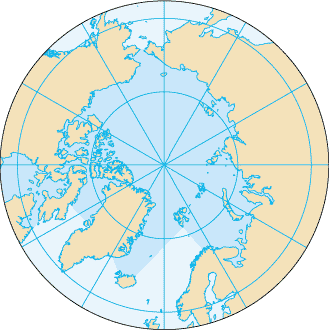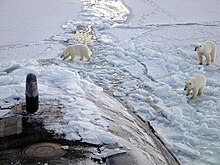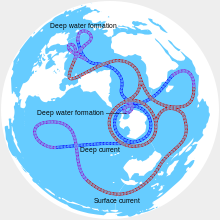Arctic Ocean: Difference between revisions
TransUtopian (talk | contribs) →Climate: making the GFDL images appear. Apparently a different hyphen in the filename is used. |
|||
| Line 105: | Line 105: | ||
* [http://www.wired.com/news/technology/0,1282,63980,00.html ''Search for Arctic Life Heats Up'' by Stephen Leahy] |
* [http://www.wired.com/news/technology/0,1282,63980,00.html ''Search for Arctic Life Heats Up'' by Stephen Leahy] |
||
* [http://www.polarfoundation.org/ International Polar Foundation] |
* [http://www.polarfoundation.org/ International Polar Foundation] |
||
* [http://video.google.com/videoplay?docid=846342022276396533&q=north+pole Video of scientists on sea ice at the North Pole as it begins to crack underfoot] |
|||
[[Category:Arctic]] |
[[Category:Arctic]] |
||
Revision as of 01:22, 12 October 2006
| Earth's ocean |
|---|
|
Main five oceans division: Further subdivision: Marginal seas |


The Arctic Ocean, located mostly in the Arctic north polar region, is the smallest of the world's five oceans and the shallowest. Even though the International Hydrographic Organization (IHO) recognizes it as an ocean, oceanographers may call it the Arctic Mediterranean Sea or simply the Arctic Sea, classifying it as one of the mediterranean seas of the Atlantic Ocean.
Much of the ocean is covered by sea ice, either during the colder months or year-round. Little marine life exists where the ocean surface is covered with ice throughout the year. The Arctic Ocean's temperature and salinity vary seasonally as the ice cover melts and freezes; its salinity is the lowest on average of the five major seas, due to low evaporation, as well as limited outflow to the world ocean with heavy freshwater inflow.
The greatest inflow of water comes from the Atlantic by way of the Norwegian Current, which then flows along the Eurasian coast. Water also enters from the Pacific via the Bering Strait. The East Greenland Current carries the major outflow. Ice covers most of the ocean surface year-round, causing subfreezing temperatures much of the time. The Arctic is a major source of very cold air that inevitably moves toward the equator, meeting with warmer air in the middle latitudes and causing rain and snow. Marine life abounds in open areas, especially the more southerly waters. The ocean's major ports are the Russian cities of Murmansk and Arkhangelsk. The Arctic Ocean is important as the shortest air route between the Pacific coast of North America and Europe overflies it.
Geography
The Arctic Ocean occupies a roughly circular basin and covers an area of about 14,056,000 square km (5,440,000 mi²), slightly less than 1.5 times the size of the United States. The coastline length is 45,389 kilometers (28,203 mi). Nearly landlocked, it is surrounded by the land masses of Eurasia, North America, Greenland, and several islands. It includes Baffin Bay, Barents Sea, Beaufort Sea, Chukchi Sea, East Siberian Sea, Greenland Sea, Hudson Bay, Hudson Strait, Kara Sea, Laptev Sea, White Sea and other tributary bodies of water. It is connected to the Pacific Ocean by the Bering Strait and to the Atlantic Ocean through the Greenland Sea. Its geographic coordinates are: 90°00′N 0°00′E / 90.000°N 0.000°E
An underwater mid-ocean ridge, the Lomonosov Ridge, divides the deep sea North Polar Basin into two basins: the Eurasian, or Nansen, Basin, (after Fridtjof Nansen) which is between 4,000 and 4,500 meters (13,000 and 15,000 ft) deep, and the North American, or Hyperborean, Basin, which is about 4,000 meters (13,000 ft) deep. The topography of the ocean bottom is marked by fault-block ridges, plains of the abyssal zone, ocean deeps, and basins. The average depth of the Arctic Ocean is 1,038 meters (3,407 ft). [1]. The deepest point is in the Eurasian Basin deepest point, at 5,450 meters (17,881 ft).
The Arctic Ocean contains a major chokepoint in the southern Chukchi Sea, which provides northern access to the Pacific Ocean via the Bering Strait between North America and Russia. The Arctic Ocean also provides the shortest marine link between the extremes of eastern and western Russia. There are several floating research stations in the Arctic, operated by the U.S. and Russia.
History
For several centuries in the Middle Ages, it was believed that the Arctic Ocean and the North Pole consisted of a magnetic island surrounded by a giant whirlpool and four continents. This belief was based on the lost book "Inventio Fortunata" which influenced cartography up until the 17th century.
Maps were only revised when the region was explored and mapmakers obtained knowledge of the true geography of the Arctic from the 16th and 17th centuries onward.
Fridtjof Nansen was the first to make a naval crossing of the Arctic Ocean in 1896. The first surface crossing of the Arctic Ocean was led by Wally Herbert in 1969, in a dogsled expedition from Alaska to Svalbard with air support.
Climate


The ocean is contained in a polar climate characterized by persistent cold and relatively narrow annual temperature ranges. Winters are characterized by continuous darkness, cold and stable weather conditions, and clear skies; summers are characterized by continuous daylight, damp and foggy weather, and weak cyclones with rain or snow.
There is considerable seasonal variation in how much pack ice covers the Arctic Ocean. Much of the ocean is also covered in snow for about 10 months of the year. The maximum snow cover is in March or April — about 20 to 50 centimeters (8 to 20 in) over the frozen ocean.
Natural resources
Petroleum and gas fields, placer deposits, polymetallic nodules, sand and gravel aggregates, fish, seals and whales can all be found in abundance in the region.
The political dead zone near the center of the sea is also at the center of a mounting dispute between the United States, Russia, Canada, Norway, and Denmark. It is considered significant because of its potential to contain as much as or more than a quarter of the world's oil and gas resources, the tapping of which could greatly alter the flow of the global energy market. The Arctic's New Gold Rush - BBC
Natural hazards
Ice islands occasionally break away from northern Ellesmere Island, and icebergs are formed from glaciers in western Greenland and extreme northeastern Canada. Permafrost is found on most islands. The ocean is virtually ice locked from October to June, and ships are subject to superstructure icing from October to May.
Plantlife
The Arctic Ocean has relatively little plant life except for Phytoplankton. Phytoplankton is a crucial part of the ocean and there are massive amounts of it in the Arctic. Marine wise the Arctic ocean is the best. There are enourmous amounts of phytoplankton because during the summer the sun is out day and night. Phytoplankton can reproduce by splitting itself, and gets energy from the sun. Nutrients from the gulfstream and currents wash in too.
Environmental concerns
Endangered marine species include walruses and whales. The area has a fragile ecosystem which is slow to change and slow to recover from disruptions or damage. The polar icepack is thinning, and there is a seasonal hole in ozone layer over the North Pole.
Reduction of the area of Arctic sea ice will have an effect on the planet's albedo, thus possibly affecting global warming. Many scientists are presently concerned that warming temperatures in the Arctic may cause large amounts of fresh meltwater to enter the North Atlantic, possibly disrupting global ocean current patterns. Potentially severe changes in the Earth's climate might then ensue.
Major ports and harbors

- Churchill, Manitoba, Canada
- Inuvik, Canada
- Prudhoe Bay, Alaska, United States
- Barrow, Alaska, United States
- Pevek, Russia
- Tiksi, Russia
- Dikson, Russia
- Dudinka, Russia
- Murmansk, Russia
- Arkhangelsk, Russia
- Kirkenes, Norway
- Vardø, Norway
References
Bibliography:
- Neatby, Leslie H., Discovery in Russian and Siberian Waters 1973 ISBN 0-8214-0124-6
- Ray, L., and Stonehouse, B., eds., The Arctic Ocean 1982 ISBN 0-333-31017-9
- Thorén, Ragnar V. A., Picture Atlas of the Arctic 1969 ISBN 0-8214-0124-6
Based on public domain text by US Naval Oceanographer: http://oceanographer.navy.mil/arctic.html
- Matthias Tomczak and J. Stuart Godfrey. 2003. Regional Oceanography: an Introduction. ISBN 81-7035-306-8 (see the site)
See also
External links
- The Hidden Ocean Arctic 2005 Daily logs, photos and video from exploration mission.
- Oceanography Image of the Day, from the Woods Hole Oceanographic Institution
- Arctic Council
- The Northern Forum
- Arctic Environmental Atlas Interactive map
- NOAA Arctic Theme Page
- NOAA In-situ Ocean Data Viewer Plot and download ocean observations
- Arctic time series: The Unaami Data collection
- NOAA North Pole Web Cam Images from Web Cams deployed in spring on an ice floe
- NOAA Near-realtime North Pole Weather Data Data from instruments deployed on an ice floe
- Search for Arctic Life Heats Up by Stephen Leahy
- International Polar Foundation
- Video of scientists on sea ice at the North Pole as it begins to crack underfoot



